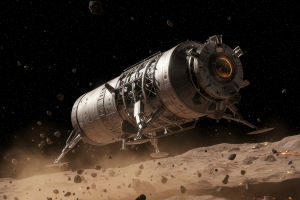Comet tails are among the most spectacular sights in the night sky, stretching for millions of kilometers and glowing with delicate, ethereal beauty. Yet behind their appearance lies a complex interplay of heat, radiation, and charged particles.
As a comet journeys from the frigid outskirts of the Solar System toward the Sun, its icy nucleus begins to warm, releasing clouds of gas and dust that form a vast glowing halo—the coma.
From this coma, sunlight and the solar wind sculpt two distinct tails: a dust tail that curves gracefully along the comet’s path and an ion tail that streams directly away from the Sun. Together, these structures serve as natural laboratories, revealing both the ancient materials from which the Solar System formed and the dynamic forces shaping space today.
Anatomy and Formation of Comet Tails
When a comet journeys from the cold outer reaches of the Solar System toward the inner regions near the Sun, intense solar radiation heats its nucleus—a compact core primarily composed of ice, dust, and frozen gases. This heating causes volatile substances to sublimate (transition directly from solid to gas), releasing gas and dust particles into the surrounding space, creating a large, diffuse envelope called the coma.
The forces exerted by sunlight and solar wind on the coma produce two distinct tails with differing compositions and behaviors:
Dust Tail: Comprised of small solid particles released from the comet’s nucleus, the dust tail forms as sunlight exerts radiation pressure that pushes these particles away from the comet. The heavier dust grains tend to follow curved trajectories influenced by the comet’s orbital path, often resulting in a curved tail that can sometimes appear straighter or even as an "anti-tail" due to Earth’s viewing angle.
Ion Tail (Gas Tail): Made primarily of ionized gas molecules such as CO+, CO2+, CH+, OH+, and H2O+, the ion tail is shaped and directed by the solar wind—a high-speed stream of charged particles emitted continually from the Sun. Ultraviolet radiation ionizes these gas particles in the coma, and the resulting ions are carried away along electric and magnetic field lines embedded in the solar wind.
Tail Size, Structure, and Dynamics
The sizes of comet tails can be astonishing. While the solid nucleus of a comet is relatively small—typically under 30 kilometers in diameter—the coma can rival or exceed the size of the Sun itself in diameter. Ion tails have been observed to extend hundreds of millions of kilometers into space.
A key element in tail formation is the interaction of the comet’s out-gassed materials with the Sun’s magnetic field carried by the solar wind. This interaction induces a magnetosphere around the comet, creating a bow shock in the solar wind upstream of the comet’s motion. The magnetic field lines drape around the comet and form the backbone of the ion tail’s plasma flow.
Viewing Perspectives and Orbital Impacts
The apparent shape and direction of comet tails depend heavily on the Earth’s relative position. For instance, the dust tail sometimes appears to curve backward along the comet’s orbit path. In rare cases, Earth’s vantage point aligns with the comet’s orbital plane in such a way that an antitail (which appears to point toward the Sun) becomes visible due to projection effects.
Comet tails also serve as natural laboratories that demonstrated the existence and properties of the solar wind early in space science history. The tails consistent orientation away from the Sun provided crucial proof that solar material streams continuously outward, influencing many bodies in the Solar System.
Dr. Jane L. Grimshaw, planetary scientist and comet researcher, elucidates the importance of understanding comet tails: “Comet tails are dynamic witnesses of solar interactions, carrying vital chemical and physical clues about the primordial material from which our Solar System formed. They also act as sensitive probes of solar wind conditions".
Dr. Thomas E. Barker, astrophysicist specializing in plasma interactions, notes: “The dual nature of comet tails—dust and ionized gas—reflects the interplay of forces at vastly different scales, from solid particle dynamics under radiation pressure to plasma physics driven by solar magnetism. Studying these tails expands our knowledge of space weather and plasma environments".
Scientific and Exploratory Significance
Comet tails not only fascinate observers but also provide significant scientific insights. The composition of tails reveals the pristine, ancient material of the early Solar System, while tail dynamics enhance understanding of solar-terrestrial interactions. Space missions such as ESA’s Rosetta, which orbited comet 67P/Churyumov-Gerasimenko, investigated the tails formation and gas/dust emissions directly, deepening comprehension of comet behavior.
The study of comet tails also impacts the broader understanding of:
- Solar wind properties and variations.
- The evolution and lifetime of cometary bodies.
- The mechanisms governing plasma interactions in space environments.
Comet tails are intricate, multifaceted phenomena shaped by sublimation of volatile materials, solar radiation pressure, and charged particle flows in the solar wind. This understanding continues to grow as telescope observations, spacecraft data, and theoretical models integrate, illuminating the complex, elegant mechanisms that create the iconic tails trailing the visitors from the deep reaches of space.


